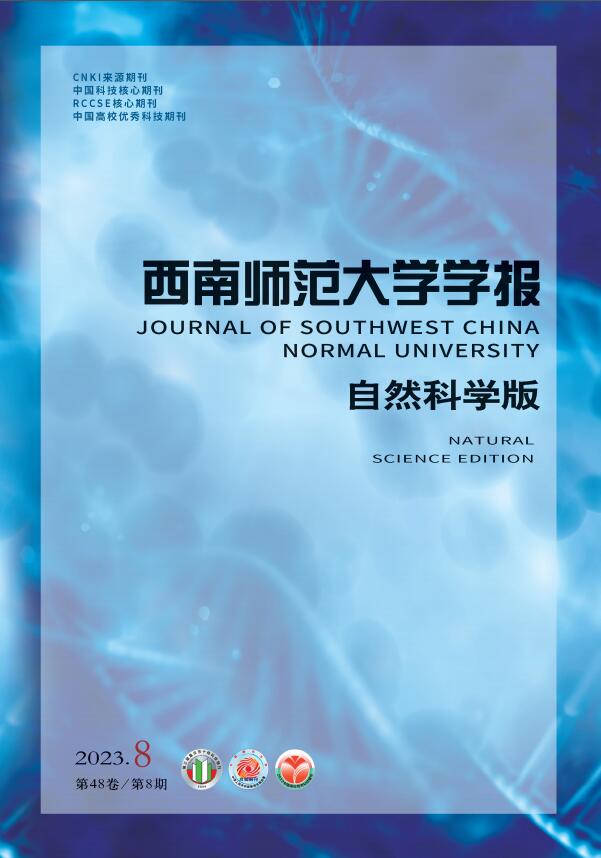-
趋化现象最早在文献[1-2]中提出,描述的是生物学中由于化学物质的影响,细胞进行定向运动的现象. 众所周知,细菌细胞一般是生活在各种各样的粘性流体当中的,所以近十年来趋化-Navier-Stokes方程[3-7]已经成为生物学家和数学家们比较关注的数学模型. 对于趋化-Navier-Stokes方程,前人关于它在不同边界条件下解的存在情况已有了很多研究[8-12]. 但是对于该系统吸引子的存在性的研究甚少. 本文主要讨论二维有界域下的趋化-Navier-Stokes方程的全局吸引子. 趋化-Navier-Stokes方程如下:
下面是这个方程的初边值条件:
在这个模型中,Ω⊂
$\mathbb{R}^2$ 是一个带有光滑边界Γ:=∂Ω的有界区域. 其中ν(x)是x∈Γ上的单位外法向量,φ是重力势并且有▽φ∈L∞(Ω),Δφ=0,n表示细菌的种群密度,c代表化学浓度,p和u=(u1,u2)分别代表流体的压力和速度. 设n(x,t),c(x,t)是关于空间x∈Ω和时间t>0的连续函数,因为c是化学浓度,故可设M(t)=$\mathop {\sup }\limits_{x \in \mathit{\Omega}}$ c(x,t)≤γ <$\frac{1}{4}$ .再设f,g可导,f(0)=0,g(0)=0并满足下列条件:
(ⅰ)
$\sup\limits_{y>0} \frac{f(y)}{y} < -C$ ,其中C是正常数;(ⅱ)
$\sup\limits_{y \in[0, 1]} \frac{g(y)}{y}$ < λ1,λ1=λ1(Ω),其中λ1是依赖于Ω的常数;假设细菌和化学物质在一种不可压缩的流体(如水)中求解,利用Navier-Stokes方程中的速度u来模拟其流动,由于重力势的存在,细菌细胞的重量将会影响流体的流动.
本文主要包含了以下几个部分.
第1部分,给出了半群和吸引子的定义、吸引子的存在性定理;讨论了n,c是正解及解的适定性,从而方程(1)-(4)决定了一个解半群.
第2部分,证明趋化-Navier-Stokes方程(1)-(4)所对应的解半群在所研究的空间上存在正向不变的有界吸收集. 前人在处理这部分时是将趋化-Navier-Stokes方程看作一个整体来证明其系统的吸收性,但由于方程(1)-(4)的复杂程度,采用整体法无法处理其吸收性. 因此我们可以利用此方程的强耦合性,将它分成3部分来处理. 首先利用能量估计等方法证明化学浓度c的吸收集是存在的,再从c的吸收集出发证明细菌种群密度n的吸收集存在,最后由n的吸收性证明了流体速度u的吸收集存在,综上所述得到了(n,c,u)的吸收集是存在的.
第3部分,证明方程所对应的解半群是一致渐近紧的. 首先得到u的光滑性,再利用方程的强耦合性,通过u的光滑性得到c的光滑性,再由u的光滑性得到n的光滑性,最后利用半群性质,得到解半群在所研究的空间上是一致渐近紧的.
HTML
-
本章节将会给出一些证明所需的基本定义和定理.
定义证明所需的空间H=L2(Ω)×L2(Ω)×(Lσ2(Ω))2,K=H01(Ω)×H01(Ω)×(Hσ1(Ω))2,Lσ2(Ω)={u∈L2(Ω);▽·u=0},Hσ1(Ω)={u∈H1(Ω);▽·u=0}以及L2(Ω)上的内积和范数分别为(u,v)=∫Ωu(x)v(x)dx,∀u,v∈L2(Ω),||u||L2=(u,u)
$\frac{1}{2}$ ,∀u∈L2(Ω).定义1[13] 设H是一个Banach空间,S(t),t≥0是一簇连续算子,它是H→H上的一个映射并且满足
则称S(t)为算子半群.
定义2[13] 如果紧集
$\mathscr{A}$ 满足下面的条件:1) 不变性:
$\mathscr{A}$ 是半群S(t)作用下的不变集,即S(t)$\mathscr{A}$ =$\mathscr{A}$ ,∀t≥0;2) 吸收性:
$\mathscr{A}$ 吸收H上的所有有界集. 即对于任意一个有界集$\mathscr{B}$ ∈H,这里的$\mathscr{B}$ 满足3)
$\mathscr{A}$ 有一个开邻域$\mathscr{U}$ ,使得对于$\mathscr{U}$ 上的任意一个n0,当t→∞时,所有从n0出来的轨迹S(t)n0都收敛到$\mathscr{A}$ . 即当t→∞时,dist(S(t)n0,$\mathscr{A}$ )→∞,则称这个紧集$\mathscr{A}$ 为半群S(t)的一个吸引子. 如果$\mathscr{A}$ 还吸收相空间H,则称$\mathscr{A}$ 为全局吸引子.引理1[13] 设{S(t)}t≥0是一个算子半群,
$\mathscr{U}$ ⊂H是一个开集,并且1)
$\mathscr{B}$ 是$\mathscr{U}$ 上的一个吸收集;2) S(t)是一致紧的(对于充分大的t),则
$\mathscr{B}$ 的ω-极限集$\mathscr{A}$ =ω($\mathscr{B}$ )是$\mathscr{U}$ 上的一个紧的全局吸引子.引理2 若(n,c,u)是方程(1)-(4)在Ω×[0,T],∀T>0中的弱解,则
证 由文献[12]可知方程(1)-(4)在没有f(n),g(c)这两项时,它的解n(x,t)>0,c(x,t)>0是成立的,则可以推出
其中A(t)=-u·▽+Δ-(▽c·▽+Δc),所以n(x,t)=
$\mathrm{e}^{\int_{0}^{t} A(s) \mathrm{d} s}$ n0>0. 因此有又因为f(0)=0,所以由中值定理可以得到
则
同理可证c(x,t)>0.
引理3[16] 如果Ω是
$\mathbb{R}^n$ 上的有界开集,那么对于任意的1≤p < ∞,u∈W01,p(Ω),有其中
$q \in\left[1, \frac{n p}{n-p}\right)$ ,C是只依赖于n,p,q,Ω的常数.引理4[13] 如果Ω是
$\mathbb{R}^n$ 上的有界开集,那么对于任意的u∈H01(Ω)n∩H2(Ω)n,v∈H01(Ω)n,w∈L2∈(Ω)n,有其中
定理1 对于给定的初值条件0 < n0,c0∈H01(Ω)和u0∈H01(Ω)2,方程(1)-(4)存在唯一的整体解(n,c,u),∀T>0有
且映射
$\left(\begin{array}{l}n_{0} \\ c_{0} \\ \boldsymbol{u}_{0}\end{array}\right) \longrightarrow\left(\begin{array}{l}n(t) \\ c(t) \\ \boldsymbol{u}(t)\end{array}\right)$ 是H→H上的连续映射.该定理给出了解的适定性,其证明主要利用Faedo-Galerkin方法[13],与文献[11]类似,本文不做过多赘述. 再结合引理2,我们得到n,c>0.
由定理1足以在空间H上定义连续的算子半群{S(t)}t≥0:
-
首先证明在H上存在有界吸收集,其过程需要在相应的空间中对解进行估计.
引理5 设
$\mathscr{B}_1$ 是L2(Ω)中的任一有界集,c是从$\mathscr{B}_1$ 中出发的方程(2)的一个解. 存在常数γ1>0和时间t1=t1($\mathscr{B}_1$ )>0,当t≥t1时,证 由条件(ⅱ)可得存在常数β∈(0,λ1)和充分大的正常数K1,使得
对方程(2)的两边分别与c作L2(Ω)的内积
由(5)式得
对K1||c||L1使用Young不等式,有K1||c||L1≤
$\frac{K_{1}^{2}|\mathit{\Omega }|}{2 \beta}+\frac{\beta}{2}$ ||c||L22,则由(6)式可得再利用Poincare不等式,存在一个常数λ1=λ1(Ω),使得||c||L22≤
$\frac{1}{\lambda_{1}^{\frac{1}{2}}}$ ||▽c||L22,c∈H01(Ω). 由(7)式得对(8)式使用Gronwall不等式,有
因此
$\limsup\limits_{t \rightarrow \infty} \| c(t) \|_{L 2}^{2} \leqslant \frac{\gamma_{1}^{2}}{2}$ ,其中$\gamma_{1}^{2}=\frac{2 K_{1}^{2}|\mathit{\Omega }|}{\beta^{2}}$ .设$\mathscr{B}_1$ 是L2(Ω)的一个有界集,${R_{{\mathscr{B}_1}}}$ 是L2(Ω)上以零点为圆心的闭球形邻域的半径,该球形邻域包含${{{\mathscr{B}_1}}}$ . 取t1=max$\left\{\frac{1}{\beta} \log \frac{R_{\mathscr{B}_{1}}^{2}}{\gamma_{1}^{2}}, 0\right\}$ . 当t≥t1时,引理6 设
${{{\mathscr{B}_2}}}$ 是L2(Ω)中的任一有界集,n是从${{{\mathscr{B}_2}}}$ 中出发的方程(1)的一个解. 存在常数γ2>0和时间t2=t2(${{{\mathscr{B}_2}}}$ )>0,当t≥t2时,证 设L2(Ω)上一球形邻域包含
${{{\mathscr{B}_1}}}$ ,其圆心为零点,半径为γ1. 由引理5知,c从L2(Ω)的有界集出发,在时刻t1后将一直在有界集${{{\mathscr{B}_1}}}$ 中. 不妨设c总在${{{\mathscr{B}_1}}}$ 中.对方程(1)的两边分别与n作L2(Ω)的内积,得到
由化学浓度c的有界性和连续性得
再由条件(ⅰ)可得f(n)≤-Cn+K1,K1是一个充分大的常数,则
对K1||n||L1使用Young不等式得
因此
由Gronwall不等式得
则
$\mathop {\lim \sup }\limits_{t \to \infty }\|n(t)\|_{L^{2}}^{2} \leqslant \frac{\gamma_{2}^{2}}{2}$ ,其中γ22=$\frac{2 K_{1}^{2}|\mathit{\Omega}|}{C^{2}}$ .设${{{\mathscr{B}_2}}}$ 是L2(Ω)的一个有界集,${R_{\mathscr{B}_{2}}}$ 是L2(Ω)上以零点为圆心的闭球形邻域的半径,该球形邻域包含${R_{\mathscr{B}_{2}}}$ . 取t2=max$\left\{\frac{1}{C} \log \frac{R_{{\mathscr{B}_{2}}}^{2}}{\gamma_{2}^{2}}, 0\right\}$ .当t≥t2时,引理7 设
${{{\mathscr{B}_3}}}$ 是(Lσ2(Ω))2中的任一有界集,u是从${{{\mathscr{B}_3}}}$ 中出发的方程(3)的一个解. 存在常数γ3>0和时间t3=t3(${{{\mathscr{B}_3}}}$ )>0,当t≥t3时,证 设L2(Ω)上一球形邻域包含
${{{\mathscr{B}_2}}}$ ,其圆心为零点,半径为γ2,由引理6知,n从L2(Ω)的有界集出发,在时刻t1+t2后仍在有界集${{{\mathscr{B}_2}}}$ 中. 不妨设总在${{{\mathscr{B}_2}}}$ 中.对方程(3)的两边分别与u作(Lσ2(Ω))2的内积,有
此时压力项将会消失,得到
再利用||▽φ||L∞ < C1和Young不等式
由(19)式
利用Gronwall不等式,
则
$\mathop {\lim \sup }\limits_{t \to \infty} \|\boldsymbol{u}(t)\|_{L^{2}}^{2} \leqslant \frac{\gamma_{3}^{2}}{2}$ ,其中γ32=$\frac{2 C_{1}^{2} \gamma_{2}^{2}}{\lambda_{1}^{2}}$ .设${{{\mathscr{B}_3}}}$ 是(Lσ2(Ω)2)的一个有界集,${R_{\mathscr{B}_{3}}}$ 是(Lσ2(Ω)2)上以零点为圆心的闭球形邻域的半径,该球形邻域包含${{{\mathscr{B}_3}}}$ . 取t3=max$\left\{\frac{1}{\lambda_{1}} \log \frac{R_{\mathscr{B}_{3}}^{2}}{\gamma_{3}^{2}}, 0\right\}$ . 当t≥t3时,综合(9),(11),(13)式可以得到在H上以零点为圆心,
${R_{\mathscr{B}}}$ =γ1+γ2+γ3为半径的有界闭球${{{\mathscr{B}}}}$ =B(0,${R_{\mathscr{B}}}$ )是(n,c,u)的有界吸收集,且是正向不变的,即H上任意有界集B⊆B(0,${R_{\mathscr{B}}}$ ),经过时间t*=t1+t2+t3后,(n,c,u)进入${\mathscr{B}}$ 中且不再离开. 故由引理5-7得到.定理2 方程(1)-(4)生成的解半群{S(t)}t≥0在空间H上存在正向不变的有界吸收集.
-
设
${{{\mathscr{B}}}}$ 是{S(t)}t≥0在H中的正向不变集. 设(n,c,u)是方程(1)-(4)的整体解. 现证明从${\mathscr{B}}$ 出发,方程的解最终都进入K的有界集,从而得到解半群{S(t)}t≥0是一致渐近紧的.引理8 ∀r>0,存在常数γ4(r)>0,当t≥r时,有
证 对(12)式从t到t+r上积分,有
让方程(3)在Ω上与-Δu作内积,得
利用引理4和Young不等式
再利用(13)式可得
由Young不等式和||▽φ||L∞≤C1
由(15),(16)式得
根据(11)式得
其中设
$\int_{t}^{t+r} \frac{27 C_{2}^{4} \gamma_{3}^{2}}{2}$ ||▽u(s)||L22ds=a1,$\int_{t}^{t+r} 2 C_{1}^{2} \gamma_{2}^{2} \mathrm{~d} s$ =a2,$\int_{t}^{t+r}$ ||▽u(s)||L22ds=a3,又由(14)式可以得到a1=$\frac{27 C_{2}^{4} \gamma_{3}^{2}}{2}$ M1(r),a2=2C12γ22r,a3=M1(r),再使用一致Gronwall引理,得这意味着对所有的t≥r,
引理9 ∀r>0,存在常数γ5(r)>0,当t≥r时,有
证 将(7)式从t到t+r上积分,有
让方程(2)在Ω上与-Δc作内积得
利用Young不等式、Hölder不等式和引理3得
由(17)式可得
这里C3是一个充分大的正常数. 由条件(ⅱ)和c在Ω×(0,∞)上的连续性知,存在ξ∈Ω,使得
由n(x,t)∈[0,∞)并且是关于空间x∈Ω的连续函数,有m(t)=
$\inf\limits_{x \in \mathit{\Omega}}$ n(x,t)≥0,则结合(19)-(20)式得到如下不等式
对(21)式从0到r上积分
由(18)式得
这意味着对所有的t≥r
引理10 ∀r>0,存在常数γ6(r)>0,当t≥r时,有
证 对(10)式从t到t+r上积分,有
由(11)式可得
让方程(1)在Ω上与-Δn作内积
利用Young不等式、Hölder不等式和引理3
由(17)和(24)式可得
这里C4是一个充分大的正常数.
由条件(ⅰ)和n在Ω×(0,∞)上的连续性知,存在ζ∈Ω,使得
由(25)-(27)式可得
对(28)式从0到r积分,得
由(23)式得
这意味着对所有的t≥r,
定理3 方程(1)-(4)生成的解半群{S(t)}t≥0是一致渐近紧的.
证 设K上以零点为圆心,RM=γ4+γ5+γ6为半径的有界闭球M=B(0,RM). 由引理8、引理9和引理10知(n,c,u)从H中的正向不变集
${\mathscr{B}}$ 出发,经过时间r后,进入K中的有界集M. 而K紧嵌入到H中,从而得到解半群{S(t)}t≥0在H中是一致渐近紧的. 证毕.由定理2和定理3以及引理1得到方程(1)-(4)在H上存在紧的全局吸引子.






 DownLoad:
DownLoad: